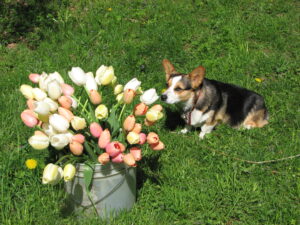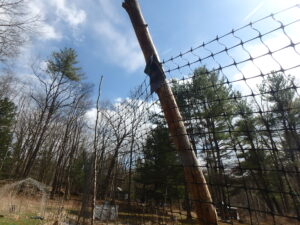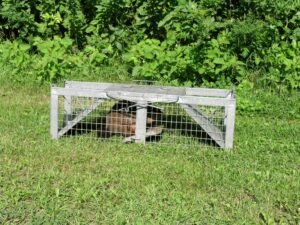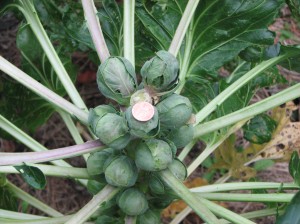Oh Dear: Dealing with Deer, Woodchucks and More
I’ve never had much trouble with deer eating my vegetables or flowers. I know gardeners who have wept when they saw that their lovely tulips had been munched by deer just when they were achieving perfection. But I’ve always had dogs, and dogs leave scents that are scary to deer. My little corgi, Daphne, leaves messages saying to the deer, “I am actually a wolf.” And they believe her.
The best repellent I’ve found are called garlic clips that I get from Gardeners Supply. These are little devices that hold garlic oil and clip onto branches. You must first puncture a seal with a little tool that comes with it. They’ve worked all winter for me on tasty shrubs.
I saw an alternative method once. The gardener bought lengths of plastic pipe, the kind used by plumbers. He cut it into 12- to 24- inch sections and buried them in the ground every 10 feet. He used either a crow bar or an auger to make holes big enough for the pipe.
Trap size is important: a woodchuck or large animal needs a trap with a 12-inch square opening that is about 36 inches long. Squirrels do fine in something with a 6-inch square door that is 18 inches long.
Rudolph and the Brussels Sprouts
Being a gardener gives me a supply of fresh vegetables, gorgeous flowers and, occasionally, good stories to tell. One of my favorite holiday stories was the time Rudolph and Santa’s reindeer found the Brussels sprouts – on Christmas Eve.
Several years ago I left a couple of Brussels sprouts plants unpicked as we approached Christmas. Given that we’d had a warm fall and early winter that year, I had just never bothered harvesting them. I had a young visitor from Scotland for the holidays that year, and Brussels sprouts are a must in Scotland on Christmas day. But the deer – or, as I told her – the reindeer got them on the night of the 24th. Ah well, Santa’s helpers needed a special treat that night.
Even though Brussels sprouts and kale are very cold tolerant, I picked mine well before Christmas this year as there is a four-point buck that has been feeding in my garden. Sigh. And winter is a time when deer predation can be a serious problem for anything edible, including trees and shrubs. What’s a gardener to do?
The best solution is to fence the area where deer are a problem. An eight-foot fence is what most experts recommend. And if there is high “deer pressure” (meaning large numbers and little natural food), a single strand of wire another foot or two above the fence may be required.
Last summer I planted and tended a small vegetable garden for friends who spend their summers in Wales. They’d had trouble with deer in their flower gardens, so I put up a fence when I planted the veggie garden for them. It was just a tiny patch, and I was able to put something up for a very reasonable cost.
Here is what I did: I bought plastic netting of the kind used to cover berry bushes to keep birds from stealing all the fruit. I bought 5 eight-foot bamboo poles, each about an inch in diameter, and a piece of one-inch plastic pipe. At each corner of the garden I pushed a pole into the soil until it was firmly in place. I used plastic tie-wraps to attach the netting to the poles (you could use tape or string for this instead).
Essentially, I wrapped the garden with mesh to keep out the deer, attaching it to each bamboo pole in turn. But after encircling the garden I didn’t attach the mesh to the first pole – if I had, there wouldn’t be any way in. Instead I attached the fencing to a fifth pole, a removable one that was right next to the first one. When I needed to enter, I lifted the fifth pole and moved it away, opening one side of the garden. That side was only 6 or 8 feet wide.
The movable pole was easy to move because it fit into a short section of plastic pipe in the ground. I tied the last bamboo pole to the first pole that was right next to it, and which was firmly anchored in the ground. When I wanted to get in, I moved that 6-foot section of fencing away and dropped the bamboo pole into another short section of plastic pipe that was in the ground at an appropriate distance away. That way I never put the fencing on the ground where it was likely to snag on something.
I have another client with a number of yews (an evergreen shrub) that were formerly the salad bar of the neighborhood deer population – but only in the winter. In summer the deer never bothered the yew. So what did we do? Cover the bushes with burlap. That keeps the deer from eating them, and offers some winter protection from cold winds.
Deer repellents work, too. The one that I like best is called Bobbex. It repels deer with its awful smell. Apply it when stems (and leaves) are dry, and the temperature is above 35 degrees. It has a number of animal proteins derived from eggs, fish and other nasties. The odor is quite offensive, even to us, for the first day or two – but much longer for the deer. They don’t want to eat the plants you have sprayed. I’ve read that the odor evokes fear in them as they approach your yew or rhododendron. It is made from all natural ingredients (no factory-made chemicals) but you should not use it on food products.
Coyote urine is another repellent that I have used, and that has worked for me. Instead of spraying it on like Bobbex, you put it in little plastic bottles that have holes in the upper portions of the sides and cotton balls in the bottom. Add the urine, hang the container on a twig or post, and the odor will drift out, keeping deer away. But it means that coyotes have to be contained in a cement floor cage with a drain to collect their urine, which can’t be a nice life, so I don’t buy it anymore. Some folks hang bars of soap from trees, too, or human hair. Deer get used to these things a bit faster than Bobbex, I believe.
So if you have deer in your neighborhood, get ready for winter. I’m not a hunter but I joke about clobbering deer on the head with a 2-by-4. I’ve seen the buck that ate some of my garden and I ran at it, shouting and barking. But that scares the neighbors, too.
You may reach Henry by email at henry.homeyer@comcast.net. His gardening website is www.gardening-guy.com.







